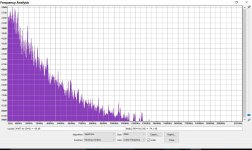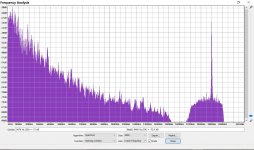And just in case there is not enough misinterpretation in this thread I give you It's Official: People Can Hear High-Res | AudioStream
I contend that the best upgrade audio needs is the journalists. He references a simple primer on Nyquist to claim
Whilst people like this are allowed to review equipment we are mired in 'a good story trumps engineering excellence'.
I contend that the best upgrade audio needs is the journalists. He references a simple primer on Nyquist to claim
the recent paper from Tim Wescott "Sampling: What Nyquist Didn’t Say, and What to Do About It" which calls into question many people's [mis]reading of the Nyquist-Shannon sampling theorem thereby shaking the very foundation of the digital world that many people have chosen to build upon.
Whilst people like this are allowed to review equipment we are mired in 'a good story trumps engineering excellence'.
Can you imagine? You turn on your DAC in the morning and nothing comes out because someone proved yesterday that it doesn't work 😀
Not only does a good story trump engineering, it also trumps reality!
Jan
Not only does a good story trump engineering, it also trumps reality!
Jan
Yes, you nearly got it right.It is difficult to imagine what this sentence might mean, but it appears to say that the noise in each channel should be correlated with the noise in the other channel. If so, all that gives is a central noise source in the stereo image. I would have thought that highly uncorrelated noise would be preferable and easier to ignore.
I am saying forceing system intrinsic/excess noise to mono centre and it essentially disappears.
Secondary effect is that embedded programme noise then subjectively reduces also, giving better apparent SNR and programme content clarity.
How, is another subject.
Dan.
So a central noise source (which may be audible) helps mask uncorrelated noise (which probably would have been less audible anyway).
How does one correlate channel noise without employing a Maxwell demon? I get it: that is how the Bybee works!! It forces the two stereo channels into quantum coherence. And all the time I just thought it was, at best, an RF filter.
How does one correlate channel noise without employing a Maxwell demon? I get it: that is how the Bybee works!! It forces the two stereo channels into quantum coherence. And all the time I just thought it was, at best, an RF filter.
Last edited:
Can you imagine? You turn on your DAC in the morning and nothing comes out because someone proved yesterday that it doesn't work 😀
Not only does a good story TRUMP engineering, it also TRUMPs reality!
Jan
Jan
Forum rules prevent discussion of politics. 🙂
noise herding? wow.
I wonder if it's easier than herding cats? ... or engineers? 😀
Jan
Forum rules prevent discussion of politics. 🙂
But... but... he also trumps reality 😀
Mods: I m OK with this post being deleted. Eventually, when you find out ;-)
The remaining question then becomes: why do we need such very high channel separation figures anyway??
What's the channel separation for a pair of loudspeakers? 😛
se
What's the channel separation for a pair of loudspeakers? 😛
se
Depends whether you ask an engineer or the marketing dept......
No, reducing and monoing system excess noise reduces system 'pollution' of throughput signal, and embedded program noise becomes subjectively reduced....to be expected.So a central noise source (which may be audible) helps mask uncorrelated noise (which probably would have been less audible anyway).
Why can't you affect the system without affecting the signal ?How does one correlate channel noise without employing a Maxwell demon? I get it: that is how the Bybee works!! It forces the two stereo channels into quantum coherence. And all the time I just thought it was, at best, an RF filter.
Dan.
Why can't you affect the system without affecting the signal ?
2nd Law.
A robot must obey orders given it by human beings except where such orders would conflict with the First Law.... 😀
Warning... audio related post. Quality of radio formats.
Mention of FM radio crops up in this thread now and again and although in the UK we have had DAB (Digital Audio Broadcasting) for many years I thought it would be fun to try an old Sony ST515L tuner that is around 40 yrs old vs DAB.
Thoughts of vinyl vs CD came to mind 😀
I switched to DAB around 10+ years ago but thought a revisit of the old vs new might be instructive. I've recorded two 3 minute clips both of which have the same content. One is FM and one DAB. Both are clearly marked in the file name. The DAB version is UK digital at its finest and highest bit rate 😉 I'll not tell you what that is yet, but suffice to say that this is as good as it gets. Many stations are on much lower bitrates, some very very much lower.
If anyone is interested I've put the audio file on Dropbox which is linked to at the end of this post (go on, have a listen). They are only 320kbs MP3's so no big downloads.
Have to that I'm slightly surprised at just how good the ancient and original Sony actually is. Unfortunately I haven't an outdoor FM aerial, just a loft job. Its not so bad though.
One of the two seems to have a much wider soundstage than the other.
The digital tuner is a dedicated 'high end' offering. A Pure DRX701ES.
Also shown here is the spectrum of both. No guess for which is which. And what's that spike at the end of one of them 😉 I used to be able to hear that once... from this very tuner.
Spectra


And here is the audio. Its a zipped folder containing one DAB file and one FM file. Both are MP3's
FM vs Digital Radio
Mention of FM radio crops up in this thread now and again and although in the UK we have had DAB (Digital Audio Broadcasting) for many years I thought it would be fun to try an old Sony ST515L tuner that is around 40 yrs old vs DAB.
Thoughts of vinyl vs CD came to mind 😀
I switched to DAB around 10+ years ago but thought a revisit of the old vs new might be instructive. I've recorded two 3 minute clips both of which have the same content. One is FM and one DAB. Both are clearly marked in the file name. The DAB version is UK digital at its finest and highest bit rate 😉 I'll not tell you what that is yet, but suffice to say that this is as good as it gets. Many stations are on much lower bitrates, some very very much lower.
If anyone is interested I've put the audio file on Dropbox which is linked to at the end of this post (go on, have a listen). They are only 320kbs MP3's so no big downloads.
Have to that I'm slightly surprised at just how good the ancient and original Sony actually is. Unfortunately I haven't an outdoor FM aerial, just a loft job. Its not so bad though.
One of the two seems to have a much wider soundstage than the other.
The digital tuner is a dedicated 'high end' offering. A Pure DRX701ES.
Also shown here is the spectrum of both. No guess for which is which. And what's that spike at the end of one of them 😉 I used to be able to hear that once... from this very tuner.
Spectra


And here is the audio. Its a zipped folder containing one DAB file and one FM file. Both are MP3's
FM vs Digital Radio
What's the channel separation for a pair of loudspeakers? 😛
se
What's the channel separation between your ears 😀
Jan
No guess for which is which. And what's that spike at the end of one of them
Mooly you mean: can you here the 19kHz stereo pilot?
I am surprised it is in the spectrum at all. Wouldn't the MPX filter be expected to make short shrift of that??
FM is supposed to be sharp filtered at 15kHz.
Jan
Last edited:
I still can't understand how to get the thermal noise in each channel (or the 1/f noise or any other excess noise) to be correlated with the other channel without using a Bybee. Could someone help me? (N.B. noise is random - the clue is in the name).
What's the channel separation between your ears 😀
Jan
Actually that shows up in audiograms of folks who have only one working ear. Tones in the bad ear will cross to the good one and get a response. As I recall it is about 70-80 dB.
- Status
- Not open for further replies.
- Home
- Member Areas
- The Lounge
- John Curl's Blowtorch preamplifier part II